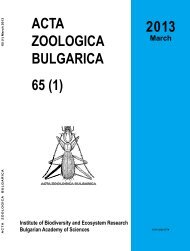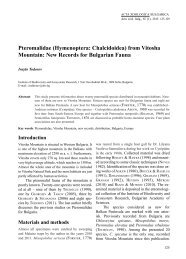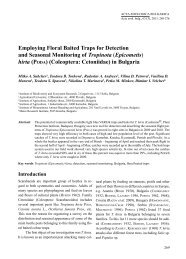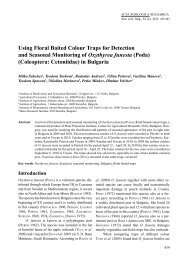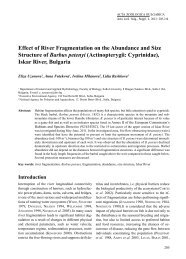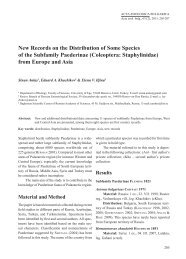Branchiobdella - Acta zoologica bulgarica
Branchiobdella - Acta zoologica bulgarica
Branchiobdella - Acta zoologica bulgarica
Create successful ePaper yourself
Turn your PDF publications into a flip-book with our unique Google optimized e-Paper software.
ACTA ZOOLOGICA BULGARICA<br />
<strong>Acta</strong> zool. bulg., 64 (3), 2012: 319-323<br />
<strong>Branchiobdella</strong> (Annelida: Clitellata) Species Found<br />
in Crayfish Collection of London Natural History Museum<br />
Mitko A. Subchev<br />
Institute of Biodiversity and Ecosystem Research, Bulgarian Academy of Sciences, 2 Gagarin str., 1113 Sofia, Bulgaria;<br />
E-mail: subchev@zoology.bas.bg<br />
Abstract: One hundred and seven samples with a total of 331 crayfishes in the crayfish collection of London Natural<br />
History Museum were examined for branchiobdellidans (crayfish worms). This included an examination<br />
of jar debris and also removing and examination of the gills of crayfishes. As a result 830 crayfish<br />
worms were found, separated and identified. The branchiobdellidans found in samples from Europe were:<br />
<strong>Branchiobdella</strong> astaci od i e r 1823, <strong>Branchiobdella</strong> parasita (br a u n 1805), <strong>Branchiobdella</strong> pentodonta<br />
Wh i t m a n 1882 and <strong>Branchiobdella</strong> hexodonta Gr u b e r 1883. Another species, <strong>Branchiobdella</strong> kozarovi<br />
Su b c h e v 1978 was found in samples from six sites in Turkey which is the first proof about recent occurrence<br />
of this species, and also of branchiobdellidans, in Asian Turkey. Examination of a rich crayfish<br />
material from UK for branchiobdellidans yielded no results.<br />
Key words: <strong>Branchiobdella</strong>, distribution, Europe, Asian Turkey<br />
Introduction<br />
Branchiobdellidans (Annelida: Branchiobdellida)<br />
are crayfish dwelling species living either on the<br />
body surface or gill chamber of their host. Four<br />
of the five European indigenous crayfish species:<br />
Astacus astacus (Linnaeus 1758), Astacus leptodactylus<br />
Eschscholtz 1823, Austropotamobius torrentium<br />
(Schrank 1803) and Austropotamobius<br />
pallipes, Kessler 1876, are known to be hosts for<br />
<strong>Branchiobdella</strong> sp. (Su b c h e v, Sta n i m i r o va 1998,<br />
Kl o b u ć a r et al. 2006). The only European species<br />
on which branchiobdellidans have not been reported<br />
so far is Astacus pachipus Rathke 1837. Among<br />
members of Branchiobdellida, <strong>Branchiobdella</strong> is the<br />
only indigenous genus known in Europe. However,<br />
together with their hosts two North American branchiobdellidan<br />
species were introduced into Europe –<br />
Xironogiton victoriensis Gelder & Hall 1990<br />
and Cambarincola mesochoreus Hoffman 1963<br />
(ne S e m a n n, ne u b e rt 1999, Ge l d e r 2006).<br />
One of the ways to study species diversity and<br />
distribution of branchiobdellidans and other crayfish<br />
epibionts like aeolosomatid Hystricosoma chappuisi<br />
mi c h a e l S e n 1926 and copepod Nitokra divaricata<br />
(= Nitocrella divaricata) ch a p p u i S 1923 is an examination<br />
of museum crayfish collections. Recently<br />
such investigations have been successfully done by<br />
the author and results published for Natural History<br />
Museums in Berlin (Su b c h e v 2007), Paris (Su b c h e v<br />
2008), Stockholm (Su b c h e v 2009) and Vienna<br />
(Su b c h e v, Ge l d e r 2010). Here are reported the results<br />
obtained from the examination of the crayfish<br />
collection in London Natural History Museum.<br />
Materials and methods<br />
The examination of crayfish body surface, crayfish<br />
gills, as well jar debris, has been done by stereomicroscope<br />
as described earlier (Su b c h e v 2007). Total<br />
319
Subchev M.<br />
of 107 samples containing 331 crayfishes have been<br />
examined. Branchiobdellidans found were identified<br />
by body form and size and, when needed, by jaw<br />
form and male reproductive system (Su b c h e v 1984,<br />
ne S e m a n n, ne u b e rt 1999)<br />
Results<br />
The results of the identification of <strong>Branchiobdella</strong><br />
species found in crayfish collection of London<br />
Natural History Museum are presented in Table 1.<br />
A total of 830 <strong>Branchiobdella</strong> specimens were<br />
found in 24 of 107 crayfish samples. The crayfish<br />
samples containing branchiobdellidans originated<br />
from seven European countries: Austria, Czechia<br />
(original name of the locations on corresponding<br />
samples were ‘Bohemia’, a historical region occupying<br />
the western two-thirds of recent Czechia<br />
(Czech Republic)), Denmark, France, Hungary,<br />
Italy, FYRMacedonia and Montenegro. In addition,<br />
branchiobdellid worms were found in a sample from<br />
a general location named ‘Medditeranean’ and in<br />
eight crayfish samples collected in Asian Turkey.<br />
The branchiobdellid species identified were:<br />
<strong>Branchiobdella</strong> astaci od i e r, 1823, <strong>Branchiobdella</strong><br />
parasita (Braun 1805), <strong>Branchiobdella</strong> pentodonta<br />
Whitman 1882, <strong>Branchiobdella</strong> hexodonta Gruber<br />
1883, <strong>Branchiobdella</strong> italica Canegallo 1928 and<br />
<strong>Branchiobdella</strong> kozarovi Subchev 1978. B. astaci<br />
was found in crayfish samples collected in Austria,<br />
Czechia and France, B. parasita in samples from<br />
Denmark and Hungary, B. pentodonta in samples<br />
from Czechia (Bohemia) and Hungary, B. hexodonta<br />
in samples from Czechia (Bohemia), Hungary, Italy,<br />
FYROM (Macedonia) and Montenegro and B. italica<br />
in samples from Italy. All B. kozarovi specimens<br />
identified were from crayfish samples collected in<br />
Turkey. A total of 12 A. leptodactylys samples and<br />
27 A. pallipes samples originated from UK were examined<br />
but no branchiobdellidan or branchiobdellidan<br />
cocoons were found neither on crayfish body including<br />
gill chamber, nor in sample debris. Similarly<br />
no branchiobdellidan cocoons were found in five A.<br />
pallipes samples from Ireland.<br />
Discussion<br />
This is first report on the presence of B. astaci in<br />
Czechia and a second report on its occurrence in<br />
Austria after Su b c h e v, Ge l d e r (2010). This species<br />
320<br />
was originally described presumably from France<br />
(od i e r 1823) and its recent presence in this country<br />
has already been confirmed by Su b c h e v (2008). B.<br />
parasita was reported for the first time for Denmark<br />
by Su b c h e v (2009) and this is the second report of the<br />
species for this country. This species together with<br />
B. pentodonta has already been reported in Hungary<br />
(Su b c h e v 1984, 2007; Ko va c z, Ju h á S z 2007). B. hexodonta<br />
is one of the most widely distributed branchiobdellidans<br />
in Europe and already found in all<br />
European countries presented in Table 1 (Su b c h e v<br />
2011). B. italica is a species originally described<br />
from Italy (ca n e G a l l o 1928) and later its presence<br />
in this country was reported by Gh e r a r d i et al. 2002,<br />
ob e r K o f l e r et al. 2002 and Qu a G l i o et al. 2006.<br />
The first report of branchiobdelidans in Asian<br />
Turkey was that of Su b c h e v (2008) who found a<br />
poorly preserved specimen in a sample from an unidentified<br />
region in Turkey in crayfish collection in<br />
French National Museum of Natural History. Later<br />
Su b c h e v, Ge l d e r (2010) gave more precise information<br />
about branchiobdellid fauna in this country<br />
reporting B. kozarovi from two Turkish localities<br />
both situated in western part of Asian Turkey:<br />
Sabanca lake and a location near Bursa. However<br />
in both these cases branchiobdellidans were found<br />
in crayfish samples collected at the end of XIX century.<br />
Thus the new data reported here are the first<br />
proof about recent presence of B. kozarovi in Asian<br />
Turkey. With numerous branchiobdellid worms<br />
in samples of crayfishes from several localities all<br />
from Western Turkey, B. kozarovi could be stated as<br />
a quite common species in this part of the country.<br />
It is worth mentioning that another six samples of<br />
crayfishes from Asian Turkey examined were free<br />
of branchiobdellid worms. Recently fa r d, Ge l d e r<br />
(2011) reported B. kozarovi from Iran. Summarizing<br />
the data available so far they concluded that the association<br />
of species on A. leptodactylus appeared<br />
to be endemic to Eastern Euro-Mediterranean subregion,<br />
according to the zoogeographical system of<br />
bá n á r e S c u (1990), with apparent focus in the countries<br />
around Black Sea.<br />
le e K e, pr i c e (1963) reported B. astaci from<br />
Reading on A. pallipes crayfishes which is the only<br />
report of a branchiobdellidan in the country. This is<br />
documented by some worms and crayfish gill bearing<br />
cocoons (1964;11:1/17&18/23) deposited in<br />
Oligochaeta collection of London National Museum<br />
of Natural History. Besides our failure to find bran-
Locality, as appeared<br />
on the label of the<br />
crayfishes; catalogue<br />
number<br />
<strong>Branchiobdella</strong> (Annelida: Clitellata) Species Found in Crayfish Collection of London....<br />
Table 1. <strong>Branchiobdella</strong> species found in crayfish samples in Crustacean collection of London Natural History Museum.<br />
Austria, Tyrol, 1873;<br />
1976:223<br />
Bohemia [Czechia]<br />
98.5.7.636-37<br />
Bohemia [Czechia]<br />
1905.V.31.3-6<br />
Crayfish species, number<br />
of the specimens<br />
<strong>Branchiobdella</strong> sp.: location<br />
of founding – number of the<br />
specimens<br />
1 2 3 4<br />
Denmark, Pond in Frederiksborg,<br />
Slotspark,<br />
Hillerød, N.E. Zealand;<br />
1905.6.10.1-10<br />
France, Mont pellier,<br />
1874;<br />
1976: 224<br />
Hungary,<br />
Cserna river near<br />
Vajda-Hunyad;<br />
1905.8.20;<br />
1906.3.16.13-22<br />
Hungary, Meleghegy<br />
(Konitat Gömör),<br />
1905.7.13; 1906.3.16.<br />
29-34<br />
Italy, Firenzuola,<br />
45 km NNE frome<br />
Florence, 1976:226<br />
Italy, 15 km N of<br />
Florence, 1970; 1976: 228<br />
Italy, Scarperia, 30<br />
km N from Florence,<br />
19.9.70; 1976:225<br />
Italy, Lake of<br />
Viverone, Piedmont,<br />
1905.5.13.20-I<br />
Italy, Vestena, near Verona,<br />
1905.V.31,12-15<br />
Italy, Ivrea<br />
1905.5.31.24-25<br />
Macedonia [FYROM],<br />
1918,<br />
1925.6.5.1-2<br />
A. pallipes italicus, 1 B. astaci: gills – 4 adult<br />
A. astacus, 3 B. astaci: gills – 2 adult, 1 juv.<br />
A. astacus, 4<br />
A. astacus, 2<br />
A. pallipes pallipes, 1<br />
B. hexodonta: gills -2 adult;<br />
B. pentodonta: debris – 2 adult<br />
B. parasita: debris – 4 adult,<br />
12 juv.<br />
B. sp.: debris – 1 adult;<br />
B. astaci: gills – 3 adult.<br />
A. astacus, 12 B. pentodonta: debris – 1 adult<br />
A. (fluviatilis) astacus, 5<br />
B. parasita: debris – 5 adult<br />
B. hexodonta: gills – 2 adult<br />
A. pallipes, 2 B. italica: debris – 2 adult<br />
A. pallipes pallipes, 2 B. sp.: gills – 1 adult<br />
A. pallipes italicus, 2 B. sp.: gills – 10 adult<br />
A. pallipes pallipes, 2 B. italica?: debris – 2<br />
A. pallipes, 4 B. sp.: gills – 2 adult<br />
A. pallipes italicus, 2<br />
A. torrentium, 2<br />
B. hexodonta: gills – 1 adult<br />
1 juv.<br />
B. hexodonta: debris – 1 adult;<br />
B. hexodonta: gills – 8 adult<br />
Notes<br />
Worms in a very bad<br />
condition; cocoons in<br />
the gills<br />
Worms in a very bad<br />
condition; cocoons in<br />
the gills<br />
Worms in a very bad<br />
condition<br />
Worms dried; cocoons<br />
in the gills<br />
Worms in a very bad<br />
condition<br />
Cocoons in the gills and<br />
on the host abdomen<br />
Worms in a very bad<br />
condition<br />
Cocoons in the gills and<br />
debris<br />
Worms in a very bad<br />
condition; cocoons in<br />
the gills<br />
Cocoons in the gills<br />
Worms from the debris<br />
in a very bad condition;<br />
cocoons in the gills<br />
321
Subchev M.<br />
Table 1. Continued<br />
chiobellidans on crayfish collected in the UK reported<br />
here, Ge l d e r (1999) also failed to find branchiobdellidans<br />
on any of over 200 endemic crayfish<br />
collected from the Aire and Ouse river basins in<br />
Northeast England. Thus, bearing in mind the note<br />
of le e K e, pr i c e (1963) in their paper that the worms<br />
found by them ‘may have obtained from imported<br />
322<br />
1 2 3 4<br />
Mediterranean,<br />
1873:26<br />
Montenegro, River<br />
Zetta (Zeat), South of<br />
Nikšić,<br />
1906.5.15.1-2<br />
Turkey, lakes, exact<br />
condition is not known;<br />
1976<br />
Turkey (Bandirma),<br />
Manyas lake, 27.8.75;<br />
1976: 164<br />
Turkey, Iznik lake,<br />
25.8.1975; 1976:162<br />
Turkey, Poyrazlar/<br />
Poytazlar lake,<br />
22.8.1976<br />
Turkey, Calticak lake,<br />
21.8.1976<br />
Turkey, Terkos lake,<br />
26.8.1976<br />
Turkey, Sapanca lake,<br />
24.8.1976<br />
Turkey, Apolyont lake,<br />
16.8.1975;<br />
1976:160<br />
A. leptodactylus salinus, 1 B. astaci: gills – 15 adult<br />
A. pallipes italicus, 2<br />
B. hexodonta: debris – 36<br />
adult, 25 juv.;<br />
B. hexodonta: gills –30 adult<br />
Worms dried; dried<br />
cocoons in the gills<br />
A. astacus, 2 B. kozarovi: gills – 1 adult Cocoons in the gills<br />
A. leptodactylus salinus, 2 B. sp.: gills – 1 adult Cocoons in the gills<br />
A. leptodactylus salinus, 2<br />
A. leptodactylus, 4<br />
A. leptodactylus salinus, 4<br />
A. leptodactylus<br />
leptodactylus, 4<br />
A. leptodactylus salinus, 1<br />
A. leptodactylus prob.<br />
salinus, 5<br />
B. kozarovi: debris – 108 adult,<br />
45 juv.; gills – 6 adult, 7 juv.<br />
B. kozarovi: debris – 87 adult,<br />
67 juv., gills – 6 adult<br />
B. kozarovi: debris – 41 adult,<br />
33 juv., gills – 5 adult, 3 juv.<br />
B. kozarovi: debris – 6 adult,<br />
gills – 1 ad.<br />
B. kozarovi: debris – 153<br />
adult, 97 juv., gills – 11 adult,<br />
B. kozarovi: debris -12 adult,<br />
6 juv., gills – 2 adult, 8 juv.<br />
Cocoons in the gills<br />
Cocoons in the gills<br />
Cocoons in the gills<br />
Cocoons in the gills<br />
crayfish’ we can not exclude that B. astaci occurs or<br />
had occurred only in Reading.<br />
Acknowledgments: Thanks are due to the members of London<br />
Natural History Museum Ms Miranda Lowe, Ms Emma Sherlock<br />
and Mr Andrew Cabrinovic for their generous assistance,<br />
Prof. Stuart R. Gelder for his helpful suggestions on the text and<br />
financial support from the European Commission’s Research Infrastructure<br />
Action via the SYNTHESYS (GB-TAF-1168).
References<br />
<strong>Branchiobdella</strong> (Annelida: Clitellata) Species Found in Crayfish Collection of London....<br />
bâ n â r e S c u p. 1990. Zoogeography of Fresh Waters. Aula-Verlag<br />
Wiesbaden, Germany: 1-1617.<br />
ca n e G a l l o m. 1928. Una nuova specie di <strong>Branchiobdella</strong> – <strong>Branchiobdella</strong><br />
italica. – Atti. Soc. Ital. Sci. Nat. Mus. Civ. Stor.<br />
Nat. Milano, 67: 214-224.<br />
far d al i ne K u i e, St u a rt r. Ge l d e r. 2011. First report of<br />
<strong>Branchiobdella</strong> kozarovi Subchev, 1978 (Annelida:<br />
Clitellata) in Iran, and its distribution in the eastern Euro-<br />
Mediterranean subregion. – <strong>Acta</strong> <strong>zoologica</strong> <strong>bulgarica</strong>, 63<br />
(1): 105-108.<br />
Gelder S. 2006. Branchiobdellidans. in: Sou t y-GroSSet, c., d. m.<br />
hol d i c h, p. y. noËl, J. d. rey n o l d S, p. h. affner (Eds,):<br />
Atlas of Crayfish in Europe. Muséum national d’Histoire<br />
naturelle, Paris, 187 p. (Patrimoines naturels, 64).<br />
Gel d e r S. r. 1999. Zoogeography of branchiobdellidans<br />
(Annelida) and temnocephalidans (Platyhelminthes)<br />
ectosymbiotic on freshwater crustaceans, and their reactions<br />
to one another in vitro. – Hydrobiologia, 406: 21-31.<br />
Gh e r a r d i f., f. ce n n i, G. cr u d e l e, m. mo r i. 2002. Infestation rate<br />
of branchiobdellids in Austrpotamobius pallipes italicus<br />
from a stream of Ventral Italy: preliminary results. – Bull.<br />
Fr. Péche Piscic., 367: 785-792.<br />
Kl o b u ć a r G., I. Ma G u I r e, S. GottSteIn-Mat o ć e c , S. Gelder 2006.<br />
Occurence of Branchiobdellida (Annelida: Clitellata) on<br />
freshwater crayfish in Croatia. Ann. Limn. – Int. J. Lim.,<br />
42 (4): 251-260.<br />
Ko v á c S t., p. Ju h á S z 2007. Data to the distribution of crayfish<br />
worms (Branchiobdellidae) in Hungary. – Folia Hist. Nat.<br />
Mus. Matraensis, 31: 77-79.<br />
leeKe c. J, a. pr i c e 1965. <strong>Branchiobdella</strong> astaci Odier (Oligochaeta,<br />
Annelida) in Reading. – Reading Nat., 17: 18-19.<br />
ne S e m a n n h., e. ne u b e rt 1999. Süßwasserfauna von Mitteleuropa.<br />
Bd. 6 Annelida. 2. Clitellata: Branchiobdellida,<br />
Acanthobdellea, Hirudinea. Spectrum Akademischer Verlag<br />
GmbH, Heidelberg, Berlin, 192.<br />
ob e r K o f l e r b., f. Qu a G l i o, l. fü r e d e r, m. l. fi o r ava n t i, S.<br />
Gia n n e t t o, c. mo r o l l i, G. mi n e l l i 2002. Species of<br />
Branchiobdellidae (Annelida) on freshwater crayfishes<br />
in South Tyrol (Northern Italy). – Bull. Fr. Pêche Piscis.,<br />
367: 777-784.<br />
od i e r A. 1823. Memoire sur le <strong>Branchiobdella</strong>, nouveau genere<br />
d’Annelides de la famille des Hirudinees. – Mém. Soc. Hist.<br />
Nat. Paris, 1: 70-78.<br />
Qu a G l i o f., c. mo r o l l i, r. Ga l u p p i, c. bo n o l i, f. ma r c h e r, l.<br />
no b i l e, G. de lu i S e, m. p. ta m p i e r i 2006. Preliminary<br />
investigations of deseas-causing organisms in the whiteclawed<br />
crayfish Austrpotamobius pallipes complex from<br />
streams of Nothern Italy. – Bull. Fr. Pêche Piscis., 380-381:<br />
1271-1290.<br />
Su b c h e v m. 1984. On Hungarian Branchiobdellids (Oligochaeta:<br />
Branchiobdellidae). Miscellanea. – Zoologica Hungarica,<br />
2: 47-50.<br />
Sub c h e v m. 2007. Branchiobdellidans (Annelida: Clitellata)<br />
found in the crayfish and annelid collections of the Natural<br />
History Museum of Humboldt University, Berlin, Germany.<br />
<strong>Acta</strong> <strong>zoologica</strong> <strong>bulgarica</strong>, 59 (3): 275-282.<br />
Su b c h e v M. 2008. Branchiobdellida (Annelida: Clitellata) found<br />
in the crayfish and annelid collections of Paris National<br />
Museum of Natural History and on recently collected<br />
crayfishes from France. – <strong>Acta</strong> <strong>zoologica</strong> <strong>bulgarica</strong>, 60<br />
(3): 233-237.<br />
Su b c h e v m. 2009. Branchiobdellida (Annelida: Clitellata) Found<br />
in the Crayfish Collection of the Swedish Museum of Natural<br />
History with Remarks on the Swedish Branchiobdellid<br />
Fauna. – <strong>Acta</strong> <strong>zoologica</strong> <strong>bulgarica</strong>, 61: 287-292.<br />
Su b c h e v m. 2011. First record of <strong>Branchiobdella</strong> Odier, 1823<br />
(Annelida: Clitellata) in Albania and an overview of the<br />
geographic distribution of <strong>Branchiobdella</strong> hexodonta<br />
Gruber, 1882 in Europe. – <strong>Acta</strong> <strong>zoologica</strong> <strong>bulgarica</strong>, 63<br />
(1): 109-112.<br />
Su b c h e v m., St u a rt r. Ge l d e r. 2010. Branchiobdellida (Annelida:<br />
Clitellata) found in the crayfish collection of the Natural<br />
History Museum in Vienna, Austria, with a re-description<br />
of <strong>Branchiobdella</strong> papillosa ne S e m a n n & hu t t e r, 2002. –<br />
<strong>Acta</strong> <strong>zoologica</strong> <strong>bulgarica</strong>, 62 (1): 33-42.<br />
Su b c h e v m., l. Sta n i m i r o va. 1998. Distribution of freshwater<br />
crayfish (Crustacea: Astacidae) and the epibionts of the<br />
genus <strong>Branchiobdella</strong> (Annelida: Branchiobdellidae),<br />
Hystricosoma chappuisi Michaelsen, 1926 (Annelida: Oligochaeta)<br />
and Nitocrella divaricata (Crustacea: Copepoda)<br />
in Bulgaria. – Hist. nat. bulg., 9: 5-18. (In Bulgarian).<br />
Received: 20.12.2011<br />
Accepted: 13.04.2012<br />
323



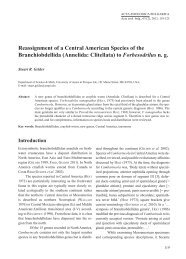
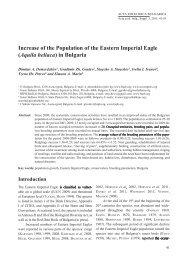
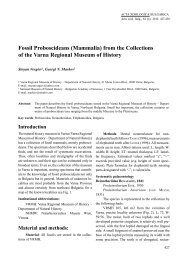
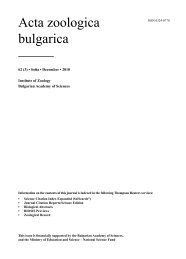
![table of contents [PDF] - Acta zoologica bulgarica](https://img.yumpu.com/52655254/1/186x260/table-of-contents-pdf-acta-zoologica-bulgarica.jpg?quality=85)
![table of contents [PDF] - Acta zoologica bulgarica](https://img.yumpu.com/52655255/1/186x260/table-of-contents-pdf-acta-zoologica-bulgarica.jpg?quality=85)
